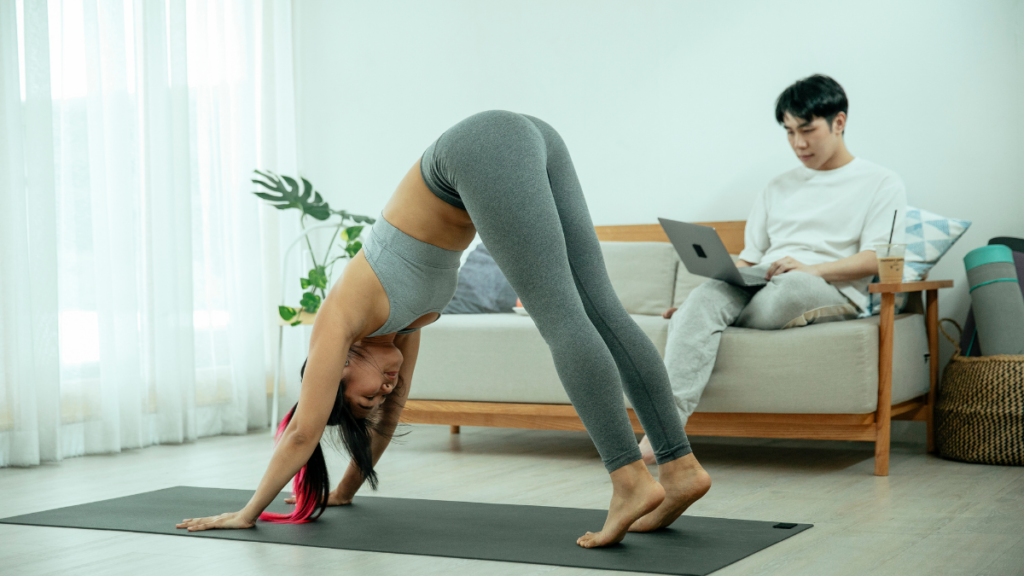Adho Mukha Svanasana commonly known as Downward-Facing Dog Pose, is a fundamental yoga pose that stretches and strengthens various parts of the body.

Here’s a step-by-step guide on how to perform this pose:
- Starting Position (Mountain Pose): Begin by standing on your mat in a neutral position, feet hip-width apart, and arms by your sides. Engage your thighs, lift your kneecaps, and gently tuck your tailbone.
- Transition to Forward Fold: Inhale and raise your arms overhead, extending your spine. As you exhale, hinge at your hips and fold forward, reaching your hands towards the floor.
- Hands and Feet Placement: Plant your palms firmly on the mat shoulder-width apart, fingers spread wide, and align your wrists with your shoulders. Step your feet back, ensuring they are hip-width apart.
- Alignment and Engagement: Spread your fingers and press your palms into the mat. Align your head between your upper arms, keeping your neck relaxed. Engage your quadriceps and lift your hips towards the ceiling.
- Forming an Inverted V-shape: Lift your tailbone towards the ceiling, pushing your heels down to the floor (or as close as possible). Your body should resemble an inverted V-shape, with your hips being the highest point.
- Straighten Your Legs: Aim to straighten your legs while keeping a slight bend at the knees if needed. Lengthen your spine, extending from your tailbone to the crown of your head.
- Deep Breathing: Take deep, steady breaths in this pose, allowing your chest and back to open up. Hold the pose for a few breaths, focusing on relaxation and lengthening.
- Modifications: If you’re a beginner or have flexibility or mobility issues, you can bend your knees slightly or keep your heels lifted off the floor. The emphasis should be on the elongation of the spine and engagement of muscles.
- Exiting the Pose: To release, gently bend your knees and lower them to the mat. Slowly transition into Child’s Pose or another comfortable resting pose.
Tips:
- Keep your head in line with your arms, avoiding excessive strain on the neck.
- Engage your core muscles to support your lower back and maintain stability.
- Focus on the stretch in the hamstrings, calves, and back while maintaining a steady breath.
Always listen to your body and adjust the pose as needed to suit your comfort level and physical capabilities. If you have any medical conditions or concerns, consult a healthcare professional before attempting yoga poses.
Adho Mukha Svanasana or Downward-Facing Dog Pose, offers a range of benefits for both the body and mind
- Stretches and Strengthens Muscles: It stretches and strengthens the entire body, particularly the arms, shoulders, back, hamstrings, and calves.
- Improves Flexibility: Regular practice enhances flexibility in the spine, shoulders, and legs, aiding in better posture and mobility.
- Enhances Circulation: The pose encourages blood flow throughout the body, boosting circulation and supplying oxygen to muscles and organs.
- Relieves Back Pain: It helps alleviate back pain by stretching and elongating the spine, releasing tension in the back muscles.
- Eases Stress and Anxiety: Downward-Facing Dog calms the mind, reduces stress, and relieves symptoms of anxiety by encouraging deep, mindful breathing and relaxation.
- Aids Digestion: This pose massages the digestive organs, promoting better digestion and relieving symptoms of indigestion and bloating.
- Tones the Abdomen: Engages the core muscles, aiding in toning the abdomen and improving core strength.
- Calms the Nervous System: The inversion nature of the pose helps soothe the nervous system, providing a sense of calm and tranquility.
- Increases Energy Levels: The pose rejuvenates the body, enhancing energy levels, and revitalizing the mind.
- Improves Posture: Regular practice helps align the spine, improving posture and reducing the risk of back-related issues.
- Builds Focus and Concentration: Holding the pose requires concentration, helping to enhance focus and mental clarity.
- Prepares for Advanced Poses: It serves as a foundational pose, preparing the body for more challenging yoga poses and sequences.
Incorporating Downward-Facing Dog Pose into your yoga practice can contribute to overall well-being, promoting a healthier body and a more balanced mind. As with any exercise, it’s essential to practice safely and within your limits. If you have specific health concerns, consult a healthcare professional before attempting yoga poses.
One thought on “Adho Mukha Svanasana: A Step-by-Step Guide and Benefits”
Comments are closed.